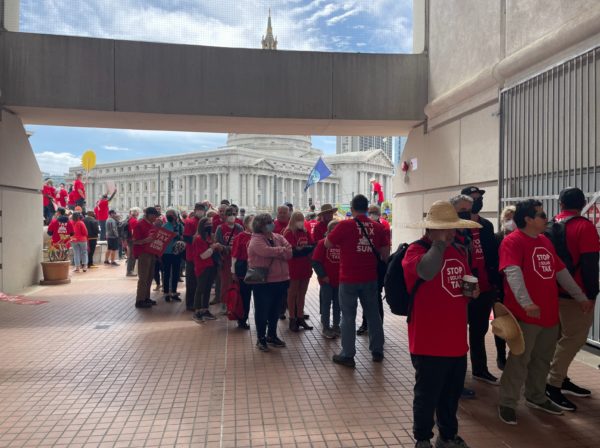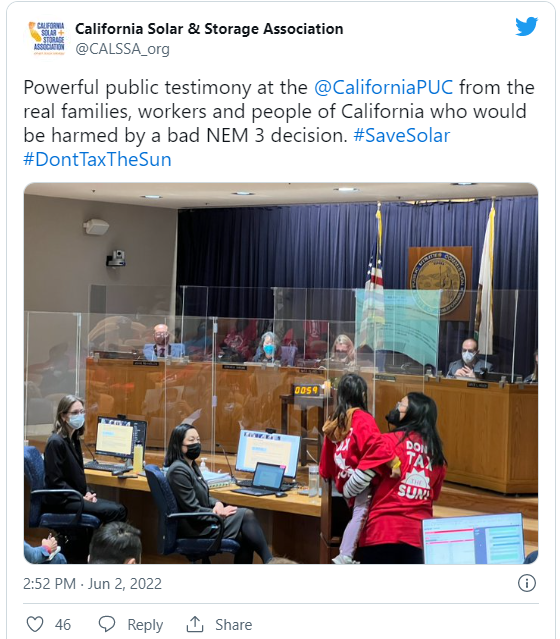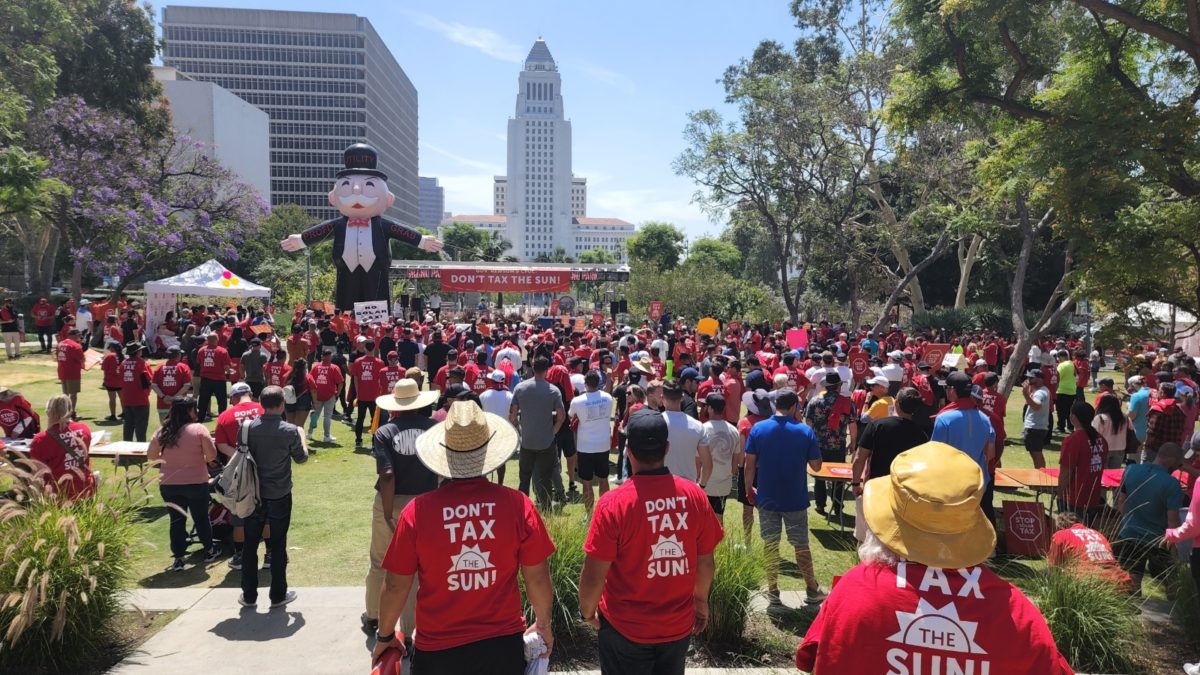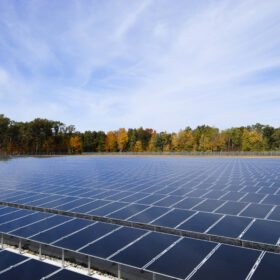A few months ago, public protest in San Francisco and Los Angeles led to the successful delay of California’s Net Energy Metering (NEM) 3.0. The proposal sharply cut payments made to solar owners for sending excess energy back to the grid to be used by their neighbors.
Renewable energy data firm EQ Analysts said the proposal would lead to a 57-71% overall reduction in solar savings for homeowners. At the time, grid controls expert and economist-at-large Ahmad Faruqui lambasted the proposed decision as a “proposed dystopia” and offered ten reasons why.
Recently, the California Public Utilities Commission (CPUC) revisited the issue, and the revised NEM 3.0 is still packed with provisions to slash payments to homeowners and increase payments to utility companies. The revision replaced monthly fixed charges based on system sizes with new solar-unfriendly provisions, including a payment “glide path”, non-bypassable charges, and a tariff to boost community solar.
The “non-bypassable charges” provision would add $0.05/kWh to a customer’s bill, whether or not they have solar panels on their roof. These charges would apply to all end-use electricity, including the electrons generated by the customer’s rooftop solar array and delivered directly to their own homes. To place this in context, the average US customer pays about $0.13/kWh for electricity nationwide. Regulations make it very difficult, or even illegal, to disconnect from the grid entirely in many areas in California.
Governor Gavin Newsom and the CPUC are decision-makers here, and as such, they were addressed by thousands of solar-supportive Californians on June 2 in a public comment event. Many testified in front of the CPUC, arguing that the non-bypassable charges and other provisions were essentially a “tax on the sun.”
Organized by the California Solar and Storage Association, large crowds gathered in Los Angeles and before the CPUC building in San Francisco. Many gave public comment, and comment can be submitted online until June 10.

Image: CALSSA

Analysis by Environment California found that rooftop solar could prevent the development of 148,000 acres of land. This is based on a state regulator estimated deployment of 28.5 GW of rooftop solar through 2045 in order to meet clean energy goals. That is an area about half the size of Los Angeles that could be preserved versus a utility-scale-only model.
The Interstate Renewable Energy Council (IREC) reports the U.S. solar industry employs about 230,000 workers, and 68,000 or more are employed in California. Over one million homes are topped with solar in the state, representing about half of US rooftop solar deployment to date.
Public comment can still be submitted to the CPUC online by June 10th, by following this link.
This content is protected by copyright and may not be reused. If you want to cooperate with us and would like to reuse some of our content, please contact: editors@pv-magazine.com.









People have to keep fighting and fighting or they’ll just be run over by these monopolies who are using customer’s payments to pay for lobbying governments to make laws to keep customers trapped and paying more and more.
With only 3% of the state’s utility power coming from rooftop solar, any mitigation on infrastructure losses caused by rooftop solar at this time is pre-mature. The utilities limited the amount of rooftop solar to 115% of the homes pre-solar installation and that is before the advent of mandatory Electrical vehicles being sold in the State and natural gas appliances for homes elimination. NEM-3.0 saw the future of the demand on the grid and raised the limit to 200% of the pre-solar electric bills but then forced a fee, based on the system size, only on those who chose to save the planet by going solar. Any connection fees should be equally paid by everyone on the grid as a fixed, non-bypass able charge and the utilities need to split the value of excess energy produced with the solar producing customer. 50% for the customers Invesment in the rooftop solar system and 50% for the utilities investment in the grid. The proposed 20% for the rooftops solar system owner and 80% for the utility grid provider was a non-starter and would pay everyone with solar to go completely off-grid with their system. All the new Solar panel systems with batteries and a transfer switch can go off-grid with the flip of a switch, the main breaker.
“non-bypassable charges”
How about they just put all their stupid ideas out there at once so they can be dispensed with.
NO, there is no justification for charging people for power they generate themselves.
Where do they get this garbage?
I think it is unreasonable to expect California’s Solar Industry not to protest the loss of their livelihood, especially with such transparently hostile regulations. Similarly the Investor Owned Utilities can’t live with NEM 1.0/2.0 if solar becomes a significant part of the electric picture. Of course that is happening and is the desired mechanism for achieving California’s goals (ie 100% renewable by 2045). Unless the plan is to fight this out in court, we should look for a win win solution.
Demand charges fix one issue. While solar customers buy no power the utility incurs costs associated with being connected to the grid. Demand charges (for everyone) would fix this without saying things that are obviously false and illegal. Solar and non-solar customers could expect about the same demand charges. The cost/kWh could be reduced to keep the bills about where they are now. This would replace the NBC scheme and the panel tax ($8/kWh).
Another issue is the price paid for solar. The ACC is pretty sketchy. It is too low and under the complete control of the utility. What keeps it from going to zero? I propose that we instead use the lowest TOU price (off-peak). At times which aren’t off-peak, the utility can profit from selling this power. Solar installations can significantly offset their bill for times when they connect to the grid. With batteries, they can do even better. As solar becomes widespread, daytime power will become plentiful and less valuable. Off-peak prices will drop, but not to zero because some customers (ie those in high rise apartments) don’t have the roof area or the money to install solar. Utilities will want to collect from them even during off-peak times. Having a constant price makes the planning a lot easier for the solar customer.
Finally, there is a problem that hasn’t appeared yet, but will. Saturday, April 30, 2022, 2:45 pm California’s electric needs were 100% met by renewables (about 2/3 of which were solar) for about 15 minutes. Natural gas plants were throttled back to 15%, The surplus was exported to other states. When there is too much solar (more than 90% of grid demand) it has to be ok for the utility to stop accepting it.
I think these suggestions would be things all parties could live with. Maybe you can improve on them. Our combative stance is an appropriate response to the ridiculous proposals put forward by the CPUC. Going forward though, compromise is going to be needed.
Let’s see. ADD 5 cents to the 29 cents they currently charge per kilo watt hour raises the amount to 34 cents. Add the current rate increases before the CPUC of 3 cents and you get 37 cents per kilo watt hour for everyone. Solar customers would pay just 5 cents from the electricity they generate and use themselves and Cities would then be able to collect their utility 5% tax on that. My home uses 1,200 kilo watt hours per month or 14,400 per year and the 5 cent non-bypass-able fee would be $720.00 per year along with the current meter fee of $120.00 gives a net cost before taxes of $840.00 plus $42.00 city utility tax equals $882.00 per year. That is just $118.00 less per year less than as replacing my 80-100-amp hour deep cycle lead acid batteries every 6 years and running my home off-grid with no utility bills. This is defiantly a “tax on the sun” that will make more people go OFF-GRID with their solar panel systems. Just turn off the main beaker and pay just $10.00 per month “Stand by Fee” to the utility and only turn it on in emergency like you would a gasoline generator. You do not disconnect from the utility; you just don’t meter the power from your off-grid batteries going directly to you sub panel not your meter panel. Just like a generator transfer switch does on systems that have backup generators or solar battery systems now. California required all new grid tied inverters installed after June 2020, to have communications that the utility can monitor what you produce, and this is how they will get you even if you do not send power back to the grid on a grid tied system but use all the power yourself. This is the “Tax the SUN” tattletale they had built in that we thought would be used to show we were part of the 50% renewable power generation club. Whoever thought that the liberal State of California would become the most anti-solar state in the nation?
The utilities are at certain disadvantages while absorbing Roof top solar generation.Not only it’s Distribution Network is used they have to sustain the the demands when solar generation is not available.They are unable to pass through such costs.A pragmatic and balanced regulations are required in order to expand the canvass of Roof top solar.
Utilities are in the business of selling electricity. So I’d say there is a perfect mechanism for recouping the costs when solar generation is low: selling electricity at a rate that covers the costs. As always.
Variability is real but it’s predictable variability and they price accordingly. Yes the. CPUC has to approve rates. That mechanism is in place.
The mistake is trying to burden solar adopters with complicated punishing schemes. Why? These people did what the policymakers wanted. Don’t punish them.
I expect if we end up heavily dependent on solar (ideally it’s a portfolio of low carbon sources) then nighttime rates will go up… a lot. What will they do? It will make energy arbitrage / storage businesses increasingly viable. Buy low (during the day) sell high when the grid needs it. So the need will be met and all you have to do is adjust prices to reflect the reality.
You are right Sir.It appears the utilities are trying to change Roof top solar prosumers in a bid to balance night tariffs. However the the consumers who relied upon Govt policies promoting RTS and invested should not be put to disadvantages.
This is why batteries and other forms of electrical storage must be built into the system and the costs must be paid by the ratepayers across the board, not just solar roof adopters that may or may not already have batteries on their own systems that must be maintained and replaced periodically. If someone already has a battery system, they should not have to pay extra for using the grid as a virtual battery while paying for their own. If the new solar system does not have batteries, then giving a two for one exchange rate to pay the utility for providing batteries would be fair. The solar panel owner would pay two kilo watt hours into the system to receive one back at no additional cost and the one the utility gets to keep, invests the sale of that kilo watt hour into the battery or storage system construction and/or maintenance. If batteries or other types of electrical storage become less costly, Utilities could lower their rates to all customers. Raising the “standby Charge” or “minimum charge” currently at $10.00 to $20.00 and using that money exclusively for building storage and resilience in micro grids, would make sense for everybody in California.
Batteries are expensive right now (about $1000/kWh) but that will change as they become more common. The technology gap that keeps me connected to the grid is the low power available from batteries right now. A typical battery has to discharge over a period of 3 hours, which means that they are fine for running the computers, televisions, lights, and refrigerators. They won’t, however, run the airconditioner, or that all-electric kitchen that is talked about. Car chargers can work, but more slowly than they do now.
An obvious advance that is starting to appear is bi-directional charging circuits on electric cars. San Jose limits battery installation to 20kWh without a lot of paperwork. A Tesla Model X has 100kWh. A Nissan Leaf has about 50kWh. The technology to plug your house into your car is coming, if it isn’t here already. Off-the-grid is becoming a real possibility
Back to the point. We want to ensure that an off-the-grid customer pays no fees or surcharges for the privilege.
-mlm
You made a lot of good points about batteries. I used deep cycle Marine/RV batteries and I parallel 20 to get 24 kilo watt hours of rating but only will get 16 kilo watt hours of useful voltage, about the same as one “Power Wall” to run my 3,000 pure sine wave inverters. From them I can run a 10,000 BTU air conditioning or 1500-watt electric heat for an 8-hour day. I have 4 sets like this and run my whole home when the sun is shining off grid. Since 12-volt systems are exempt from the national Electrical Code NEC The only thing a city can do is check if your equipment wires and fusing meets the UL or other underwriter’s laboratory requirement Article 720 NEC. lead acid batteries work out to $100.00 per kilo watt hour and must be replaced every 5 to 7 years. (6-year average)
I just received the updated costs for PG&E electrical rates as of May 1, 2022. E-TOU-C off peak, low tier is now 34 cents per kilo watt hour. Tier 2 off peak is 43 cents per kilo watt hour. Peak rates are 42 cents per kilo watt hour tier 1 and 51 cents per kilo watt hour tier2. Tier 1 is under 10 kilo watt hour per day and tier 2 is anything over 10 kilo watt hours per day. My off-grid system, including battery replacements runs about 19 cents per kilo watt hour for the batteries all of the time. I generate and use/store 600 kilo watt hours per month or 7,200 kilo watt hours per year. First installed in 2010 and added to each year for 10 years all off-grid as both a hobby and a way of keeping out of the higher tiered rates. My solar panels have already paid for themselves, but the batteries are costing $ 1,200.00 per year or $100.00 per month but are saving me $180.00 per month in utility higher tier electrical charges for a net gain of $80.00 per month at today’s electrical rates. If they ever get the promised 10,000 cycles or 28-year battery, our energy storage needs will be met.
Marshal, I just built a 14.3KWh, LiFePO4 battery for $2,570 which includes the 16 cell, 250 amp BMS. That’s $180/KWh. If instead, you want pre-built LiFePO4 batteries, you can buy them for about $320/KWh. These batteries last for around 5,000 cycles so if you cycle them once a day, that’s 13.7 years. I don’t expect that long of a life from them but certainly they’ll go for 10 years. And yes, the price is continuing to fall. So I don’t know where you got your price info from – it’s currently 3X to 5.6X too high.
Tomorrow (Wed 8/31), state lawmakers will vote on a proposal – SB 846 – to keep PG&E’s Diablo Canyon nuclear power plant open for another ten years. To pay for it, ratepayers will be charged a new fee based on “gross” energy consumption. This includes the solar energy that powers your home during the day or charges your battery. (Section 9(l) of the bill)
Taxing the sun makes no sense
This is not about the merits of nuclear power or keeping Diablo Canyon open. This is about the idiocy of taxing people even when they don’t buy energy from the utility, when they in fact are reducing their burden on the grid and helping to make the grid more reliable.
The bill would tax all solar users, current and future, when their solar panels (or batteries) power things like:
A fridge, air conditioner, wheelchair, or dialysis machine in a home
An irrigation pump on a farm
A science lab in a school
A heart monitor in a hospital
A UPS that powers your computer.
To be clear, solar users with a battery will not be spared, not even during Public Safety Power Shutoffs.
It’s hard to keep it all straight, and that’s the utilities’ plan. Let’s show the utilities and their lackeys that the public is on to them, no matter when and where they propose their nonsense.
The Solar Tax is illegal
Solar Taxes have been struck down many times in other states. That’s because it is discriminatory. People reduce their electricity consumption in many ways, such as energy efficiency and conservation. Yet, no one is proposing a tax on people who hang-dry their clothing rather than run the electric dryer! If we do not buy electrons from the utility, why should we pay the utilities for them. De-regulation was to promote competition including that from self-owned power producing solar or wind to lower prices. This is a give-a-way to the utilities who already charge more in California than all other state utilities charge their customers.
Yeah Edward, about that clothesline you’ve been using – we’re thinking you need to pay us $2.50 per foot of line per month due to avoided costs. LOL!
Dan, Edward
Way to go guys! People like you drive the state of the art.
I’m aware of the deep cycle marine option and it is about $100/kWh and can really put out some watts. I was put off by the complexity and the short life, but it is viable.
The more commercial products (eg Tesla, Enphase) cost more right now, but they will get cheaper. Still, I can’t help but notice that there is plenty of storage in my car. Furthermore, since 1 kW= 1.3 horsepower, there is plenty of power in my gas powered car/truck to cover me in a blackout. All that is missing is the engineering to use it.
Update Tuesday 8/30,2022
Tomorrow (Wed 8/31), state lawmakers will vote on a proposal – SB 846 – to keep PG&E’s Diablo Canyon nuclear power plant open for another ten years. To pay for it, ratepayers will be charged a new fee based on “gross” energy consumption not the “net” energy consumption. This includes the solar energy that powers your home during the day or charges your battery. (Section 9(l) of the bill)
Taxing the sun makes no sense
This is not about the merits of nuclear power or keeping Diablo Canyon open. This is about the idiocy of taxing people even when they don’t buy energy from the utility, when they in fact are reducing their burden on the grid and helping to make the grid more reliable.
The bill would tax all solar users, current and future, when their solar panels (or batteries) power things like:
A fridge, air conditioner, wheelchair, or dialysis machine in a home
An irrigation pump on a farm
A science lab in a school
A heart monitor in a hospital
A UPS that powers your computer.
To be clear, solar users with a battery will not be spared, not even during Public Safety Power Shutoffs.
It’s hard to keep it all straight, and that’s the utilities’ plan. Let’s show the utilities and their lackeys that the public is on to them, no matter when and where they propose their nonsense.
The Solar Tax is illegal
Solar Taxes have been struck down many times in other states. That’s because it is discriminatory. People reduce their electricity consumption in many ways, such as energy efficiency and conservation. Yet, no one is proposing a tax on people who hang-dry their clothing rather than run the electric dryer! If we do not buy electrons from the utility, why should we pay the utilities for them. De-regulation was to promote competition including that from self-owned power producing solar or wind to lower prices. This is a give-a-way to the utilities who already charge more in California than all other state utilities charge their customers.
Update, SB 846 in California has an addendum explaining the “Gross” energy consumption will only be on “utility supplied” electricity and not from Solar or battery power from rooftop solar and used exclusively by the homeowner or business. What is funny, though, is that the Diablo Canyon power plant is owned by PG&E and only supplies Northern California Customers, in its service area, with its power but the whole state and all three of its big utilities will add the non-by passable charge to their bills.
Marshall, I forgot to add, per your comment, “They won’t, however, run the airconditioner, or that all-electric kitchen that is talked about. “, not only is the 14.3 KWh DIY lithium battery I built only about 17 cents per Wh, but it runs my whole, all-electric, 1,400 sq ft house, and my pool pump that runs 11 hours a day. That includes a 4 ton central air conditioner. My battery is charged each day from 3 strings of used 250W solar panels. 18 panels total which produce about 4 KW peak during maximum summer sun. As I said, it’s an all-electric home so the solar system is running the hot water heater, central a/c, induction cook top stove and convection oven, washer & dryer, dishwasher, microwave, lights, and when needed, my table saw and other tools. So far, I haven’t run out of power even during cloudy days. I live in the SW so of course, that helps a lot.